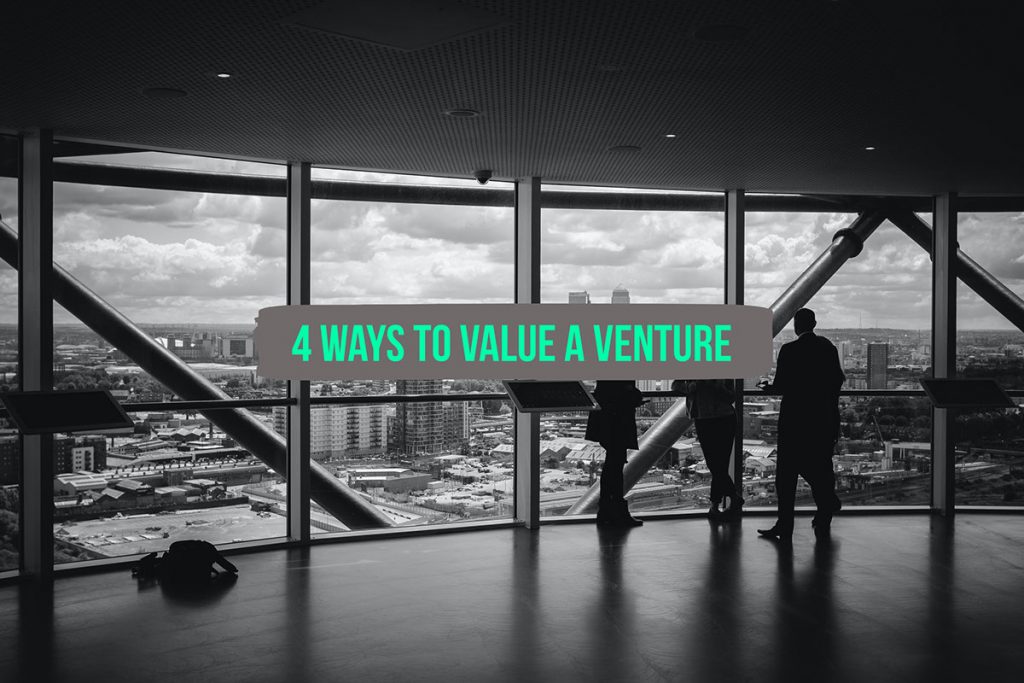Most people would agree that finance isn’t the most exciting topic in the start-up world, but when you’re fundraising or trying to exit understanding the math is critical. Investors want to ensure they are not over paying for an investment and founders are trying to justify the best price for their equity.
Here are four ways to value a venture, two for early stage ventures and two for later stage ventures.
If your company is early stage or pre-revenue then you’ll want to use one of these next two valuation methods. This chapter increases in complexity as you go, so if you feel lost you can skip ahead to the next chapter. If you’re just starting off, then I suggest you at least get past the cash flow section.
If your company is generating revenue then you can explore one of the more complicated discounted cash flow methods. If you try to use a cash flow based method before you have cash flows you will encounter pushback on your projections, so make sure they are conservative (a.k.a. they don’t look like a hockey stick) and defensible (a.k.a. you have clear and plausible assumptions).
Comparable: This is the simplest way to value a company. Look for companies in a similar space and stage that have raised funds, then use their valuation to justify yours. I typically use crunchbase.com to find this information.
Replacement value: The next easiest method is to figure out the value of each member of the team and the progress you’ve made. This method is typically used if there are no barriers to entry (such as patents, first mover advantage or strategic partners) for competitors. The table below shows an example of these values charted
If you’re a later stage company with cashflows you should probably use one of these more complex methods.
First, let’s quickly go over what your cash flows should look like. Say you’re a company generating revenue and you have operating expenditures and capital expenditures. This is a very basic example your cash flows:
| Item | 2019 | 2020 | 2021 |
| Revenues | $ 1,000,000 | $ 4,500,000 | $ 10,000,000 |
| Operating Expenditures | |||
| Salaries | $ 500,000 | $ 900,000 | $ 2,000,000 |
| Rent and Utilities | $ 100,000 | $ 175,000 | $ 400,000 |
| Services | $ 250,000 | $ 425,000 | $ 1,000,000 |
| Capital Expenditures | |||
| Facility | $ 500,000 | $ 0 | $ 0 |
| Equipment | $ 250,000 | $ 250,000 | $ 500,000 |
| Facility Improvement | $ 0 | $ 200,000 | $ 1,000,000 |
| EBITDA | $ 150,000 | $ 3,000,000 | $ 6,600,000 |
| Profit | $ (600,000) | $ 2,550,000 | $ 5,100,000 |
| Yearly NPV 25% | $ 120,000 | $ 1,920,000 | $ 3,379,200 |
| Valuation | $ 5,419,200 |
Net Present Value (NPV): In this calculation you need to put together a projection of cash flows.
The formula is:
future cash flow or EBITDA
(1 + interest rate)^time
The interest rate is calculated by finding out what the capital could have done elsewhere. I typically use 25% because of the risk.
Risk Adjusted NPV: After you have the cash flows, instead of using the simple 25% discount rate, you can use real world risks that could prevent you from getting to your ideal scenario ignorer to discount the cash flows more accurately.
You come up with the likelihood, as a percentage, a risk will cause a failure in the venture. You then multiply the percentages against each other. Using that result you subtract that from one and multiply that number by the unadjusted value.
| Risk Item | Probability |
| Team execution | 90% |
| Product/market fit | 80% |
| Contractor execution | 95% |
| Patent | 75% |
| Risk Adjustment | 51.30% |
Or perhaps your venture is high risk and high reward, thus your discount should be much higher. Imagine a venture where you have less than a 10% chance of success, but if you do succeed it will be worth $100 million dollars!
| Risk Item | Probability |
| Successful prototype | 50% |
| Successful demonstration product/service | 50% |
| Achieving the target sales rollout | 50% |
| Probability of achieving the target sales maturity | 50% |
| Overall probability of success | 6.25% |
Therefore, if you calculated a USD $100 million NPV at 10% discounted cash flow the risk net present value would be USD $6.25 million. If you valued your company at USD $10 million in other ways, you would require a 10% probability of success to achieve this value.
At the end of the day, the valuation of your company is whatever the investor(s) and you, the founder, agree upon. It is important that everyone is properly compensated for risks and efforts. The above methods are just a starting point for negotiations. Most seed or series A deals end up with investors taking 10-25% of the company.
In summary, there are several ways to structure a deal and several methods to value a company. Your end goal should be to structure a deal that works well for both parties and compensates everyone fairly. It is critical to adequately incentivize the team, compensate investors’ risk, and bring in enough money / resources to take the company to the next set of milestones.
